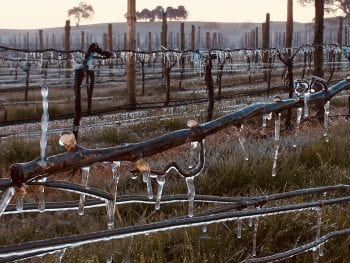You may have noticed, especially if you live in the southern part of the country, that it’s been pretty cold over the last couple of weeks.
Unseasonably so.
Which is fine for me, because I much prefer the cold over the heat – it means I can light the fire and snuggle in with a glass of red wine in hand.
BUT, if you’re a grape grower, with vines that took full advantage of the unseasonable warm patch we had a few weeks ago to snap into action, it wasn’t the greatest news.
You see, frost events at ‘budburst’ (when the vines have just woken up and start to put on new growth) are devastating.
Vineyard owners throughout the Barossa and Clare Valleys, the Riverland in South Australia, and the Riverina in New South Wales are now grappling with extensive crop losses.
But is all lost? Let’s find out in this week’s blog…
What Causes Frost?
Other than really cold temperatures?!
Frost occurs when ground-level temperatures dip below zero under clear skies and minimal wind. These conditions were met in South Australia, where Adelaide experienced its coldest September morning in a century, recording just 1.3°C. In parts of the state, temperatures plunged even lower, and the Riverland faced sub-zero conditions that severely impacted vineyards.
The thing that made these particular frosts even worse was the fact that we’ve had a super dry winter. Frosts are exacerbated by low soil moisture.
How Does Frost Impact Vineyards?
Frost freezes the young green tissue of the vine buds (which had literally just popped out to say hello signalling the beginning of the 2024/25 growing season), the sap within the bud freezes and causes cells within the bud to burst. They look as if they have been burnt. It destroys the new shoot and the tiny bunches of grapes within.
Some growers in the Riverland, Australia’s largest wine-growing region, have reported losing up to 20% of their crops. While others in the Clare Valley and Barossa regions estimate losses as high as 85% in certain vineyards.
And the news gets worse – for many, this frost marks the third consecutive year of significant crop damage due to extreme weather events.
Will Frost Affect the Quality of the Wine?
Despite the devastation, there is hope for the future quality of the wine.
You see, later in the season vines will often put on secondary bud growth and that has the possibility of yielding high-quality grapes, albeit in much lower quantities.
Secondary fruit tends to ripen later, developing more balanced and elegant flavours, which can enhance the wine’s overall quality. Any fruit that does survive the frost will still produce excellent wines.
How To Protect Vines from Frost?
To combat frost, vineyard managers employ various techniques to protect their crops.
Fans
Frost fans are widely used to circulate air and prevent ground-level temperatures from dropping too low. In the Barossa region alone, approximately 300 fans are deployed across vineyards. Helicopters can do the same job, but it’s obviously more expensive in the long term.
Water
 It might sound crazy to water during a frost, but the idea behind using sprinklers during a frost is that the water absorbs the cold air around the vine and protects the newly formed buds. The frozen water around the vine is actually “warmer” than the air. The ice protects the buds from the colder air.
It might sound crazy to water during a frost, but the idea behind using sprinklers during a frost is that the water absorbs the cold air around the vine and protects the newly formed buds. The frozen water around the vine is actually “warmer” than the air. The ice protects the buds from the colder air.
Check out the “ice igloos” around the individual buds in this photo from Kim Anderson’s vineyard a few years ago. The ice will protect the buds as long as the sprinklers run through the duration of the frost, plus the hour after sunrise (when the frost is at its worst).
Fire
The Europeans tend to start by lighting a few fires!
Hundreds of them in fact.
Candles (big ones called bougies) and burning bales of hay give off enough heat to create air movement which prevents a frost pocket from forming.
Other ways to protect against frost…
- Fact: moist soil tends to stay warmer than dry soil. A regular watering schedule, particularly in dry, cold weather can help protect the vines from freezing temperatures.
- Good weed management practices ensure that cold air is kept down low at ground level. If long weeds are left to grow around the base of the vines, then the cold air will sit up around the top of the weeds which is closer to the buds.
What Lies Ahead for Vineyards?
The frost season in this part of the world can extend well into November. Things look like they’re starting to warm up though (boo for me and my glass of red in front of the fire), so hopefully that’s it for this season.
Obviously, the damage that’s already been done is going to have a significant impact on those vineyards affected. On the upside though, we could see some really interesting wines come out of those regions in the future. Perhaps in a couple of years time, keep an eye out for a 2025 vintage wine from Clare or Barossa!
In the meantime, here’s hoping that the rest of this year’s growing season is relatively uneventful.
